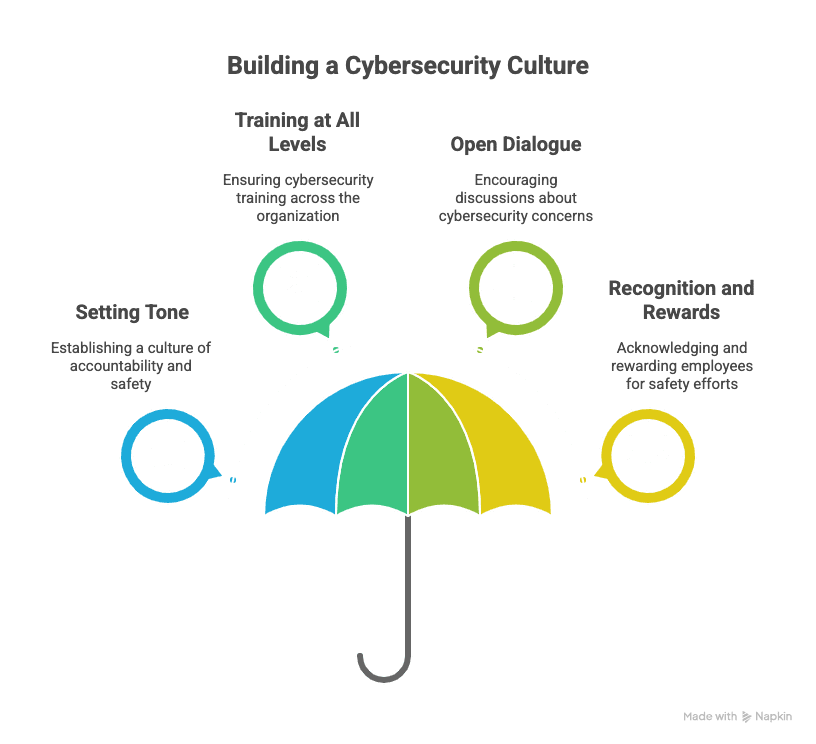Table of Contents
- Introduction
- The Evolving Cyber Threat Landscape
- Executive Cybersecurity Training: Beyond Technical Teams
- Cybersecurity Awareness for Business Leaders: A Boardroom Priority
- Cyber Risk Management: A Shared Responsibility
- Oxford Cybersecurity Course: Shaping Confident Leaders
- Leadership in Cybersecurity: Building a Culture of Vigilance
- Real-World Examples: When Leaders Made the Difference
- Key Takeaways
- Conclusion
- FAQs
Introduction
The era when cybersecurity training existed as a secluded technical activity reserved exclusively for -IT professionals has ended. The current hyper-connected data-centric environment transforms cyber threats from obscure online dangers into boardroom challenges. The responsibility of protecting organisations from cyber threats now rests heavily upon business leaders along with executives and decision-makers. And the stakes? The current levels have reached unprecedented heights.
Recent high-profile violations have demonstrated a rigorous reality: without strong leadership participation in cyber security strategy, even the most technically stronger organizations are unsafe. This is not about transforming business leaders into hackers or coorsted – it is about making them equipped with the knowledge, awareness and strategic mindset required to navigate the complex world of cyber risk. Where executive-focused cyber security training comes.
The Evolving Cyber Threat Landscape
The quantity & complexity of cyberattacks continue to expand at a rate -that frequently exceeds the defensive capabilities of organizations. The current threat environment reaches new levels of danger as ransomware attacks disable essential systems while phishing schemes aim at top corporate leaders.
A newly published IBM report indicates that the worldwide mean expense of data breaches escalated to $4. The population reached 45 million in 2023 representing a 15% growth during the preceding three years. The scope of attacker exploitation has expanded beyond technical vulnerabilities to include human gaps alongside business process flaws and inadequate strategic oversight.
| Type of Threat | Impact on Organisations | Real-World Example |
| Phishing Attacks | Compromise of executive credentials, financial loss | The Twitter Bitcoin scam of 2020 saw high-profile accounts hacked |
| Ransomware | Operational shutdown, reputational damage | Colonial Pipeline attack disrupted fuel supply across the US |
| Insider Threats | Data leakage, intellectual property theft | Tesla faced a major insider sabotage incident in 2018 |
Business leaders need to understand this evolving landscape.. not just the technical jargon -but the real-world business implications. That’s exactly why cybersecurity training must extend beyond the IT department.
Executive Cybersecurity Training: Beyond Technical Teams
Many organisations still believe cybersecurity training is best left to IT teams, technical experts, and engineers. But in reality.. executives are prime targets for cybercriminals—often referred to as ‘whale phishing’ or ‘CEO fraud’.
Executive cybersecurity training isn’t about teaching business leaders how to configure firewalls —it’s about enhancing their ability to identify risks, ask the right questions & make informed decisions that protect the organisation.
Why Leaders Need Dedicated Cybersecurity Education:
- They shape policies that directly impact the company’s security posture.
- Their decisions influence resource allocation for cybersecurity initiatives.
- Their credentials and communications are frequent targets for attackers.
- They must respond effectively to breaches and crisis situations.
A well-informed leadership team, empowered by targeted cybersecurity training, is essential for building organisational resilience in the digital age.
Cybersecurity Awareness for Business Leaders: A Boardroom Priority
Cyber incidents are not only limited to assistive IT tickets but are capable of destroying mergers, spoiling reputations, and even incurring regulatory fines. Therefore, a cybersecurity awareness campaign for business leaders is now absolutely necessary.
Just imagine—according to Gartner’s research, 88% of boards of directors consider cybersecurity a business risk, rather than only a technical risk. However, many senior executives are still unaware
Key Areas of Cyber Awareness for Leaders:
- Understanding emerging cyber threats relevant to the industry.
- Recognising social engineering tactics that target executives.
- Appreciating the legal and reputational fallout of breaches.
- Supporting a security-first organisational culture.
Without cybersecurity awareness for business leaders, even the most sophisticated security tools can be rendered ineffective.
Cyber Risk Management: A Shared Responsibility
Cyber risk is business risk—plain and simple. While technical teams handle the mechanics.. effective cyber risk management starts at the top.
Cyber risk management isn’t about eliminating risk entirely —that’s impossible.. but about identifying, assessing & mitigating threats in a way that aligns with business objectives and regulatory requirements.
| Element of Cyber Risk Management | Leadership Responsibility |
| Risk Assessment | Ensure enterprise-wide risk identification processes |
| Policy Development | Approve and champion cyber policies and frameworks |
| Incident Response | Lead crisis management efforts during cyber events |
| Continuous Training | Mandate ongoing cybersecurity training for all staff |
Without leadership buy-in and understanding of cyber risk management, organisations remain reactive and exposed.
Oxford Cybersecurity Course: Shaping Confident Leaders
For leaders seeking practical, world class education in this space, the Oxford Cyber Security Course offers a unique opportunity. Especially designed for professional authorities, the program bridges the difference between technical complications and strategic leadership.
Through the Oxford Cybersecurity Course, delivered in collaboration with Imarticus Learning, participants gain:
- A deep understanding of the global cyber threat landscape.
- Practical frameworks for effective cyber risk management.
- Insight into governance, compliance, and regulatory expectations.
- Confidence to lead cybersecurity conversations at board level.
Ready to Lead with Confidence? Enrol now for the Oxford Cybersecurity for Business Leaders Programme with Imarticus Learning.
Leadership in Cybersecurity: Building a Culture of Vigilance
Technology alone cannot defend against cyber threats – people and culture play an important role. This is why the leadership in cyber security is more than policies – it is about the cultivation of vigilance throughout the organization.

Cyber security includes effective leadership:
- Set tone for accountability and safety-conscious behavior.
- Running cyber security training running at every organizational level.
- To encourage open dialogues about cyber concerns and events.
- Recognizing and rewarding employees with safety.
Leaders who prefer cyber security make flexible organizations – where everyone understands his role in defense.
Real-World Examples: When Leaders Made the Difference
History provides countless examples of how strong leadership – or in its absence – can affect the results of cyber phenomena.
In the target data breech (2013), poor executive awareness delayed reaction efforts, resulting in significant financial and prestigious damage.
Conversely, Mercec’s response to notpatya (2017) demonstrated decisive leadership and rapid crisis management, which reduces long -term decline.
Twitter Hack (2020) highlighted how the attackers target high-profile individuals, highlighting the need for cyber security awareness for business leaders.
These cases strengthen the message: Effective cyber security training is not optional for leaders – this is a competitive and risk management mandatory.
Key Takeaways
- Cybersecurity training is essential for executives, not just IT teams.
- Business leaders are prime targets for sophisticated cyberattacks.
- Executive cybersecurity training builds strategic decision-making capacity.
- Cybersecurity awareness for business leaders fosters proactive risk management.
- The Oxford Cybersecurity Course equips leaders with vital knowledge.
- Effective cyber risk management requires leadership involvement.
- Strong leadership in cybersecurity creates a culture of resilience.
Conclusion
In a world where cyber threats crop daily & attackers grow more clever -it is not enough to fully rely on IT departments to protect an organization. Business leaders should not take steps not as technical experts, but not as an active patron of their company’s digital assets.
Investing in cyber security training is not only about compliance – it is about protecting reputation, protecting stakeholders and ensuring organizational longevity. With programs such as the Oxford Cyber Security Courses, officials can create confidence, awareness and strategic mindset necessary to safely lead their outfits in the future.
FAQs
1. Why do business leaders need cybersecurity training?
Look, leaders are the big fish—prime targets for cybercriminals. If you’re making the major calls, you’d better understand the risks out there. One misstep, and you’re risking the whole company’s wellbeing. You want resilience? That starts at the top.
2. Is cybersecurity training for non-technical professionals effective?
Absolutely. Programs like the Oxford Cybersecurity Course are built for executives, not IT pros. They cut through the tech noise and focus on what matters for leadership. Doesn’t matter if you’re not a coder—these insights are practical, actionable, and designed for decision-makers.
3. How does cyber risk management relate to business strategy?
It’s all connected. Cyber threats hit your operations, your brand, and your bottom line. If you’re not factoring cyber risk into your strategic decisions, you’re basically gambling with your company’s future.
4. What is the role of leadership in cybersecurity?
Leadership sets the agenda. Where leaders focus resources and attention, the company follows. If execs make security a priority and set a strong example, that attitude spreads. Culture starts in the boardroom.
5. Can cybersecurity awareness for business leaders reduce incidents?
Definitely. When leaders take cyber threats seriously and model secure behavior, employees notice. That tone from the top can build a culture where everyone is more vigilant—which absolutely makes a difference in reducing incidents.
6. What makes the Oxford Cybersecurity Course unique?
It’s tailored for executives—strategy, governance, real-world scenarios. Forget getting lost in technical details. It’s about what leaders need to know to keep their organizations secure and resilient.
7. How often should leaders undergo cybersecurity training?
At least annually. The threat landscape doesn’t stand still, and neither should leadership. Ongoing awareness is a must to stay ahead.
8. What are the business risks of ignoring cybersecurity?
Neglect it.. & you’re looking at data breaches, hefty fines, lost productivity, and reputation damage that can haunt you for years. The financial fallout isn’t just short-term—these problems linger.
9. Is cybersecurity a shared responsibility within organisations?
No question. IT handles the nuts and bolts, but leadership has to drive the overall strategy and culture. If it’s not a company-wide priority, you’re leaving gaps—and that’s when problems sneak in.
10. How can I enrol in the Oxford Cybersecurity for Business Leaders Programme?
You can learn more and enrol in the Oxford Cybersecurity Course via Imarticus Learning’s official website.



